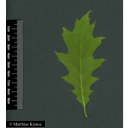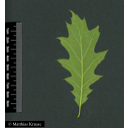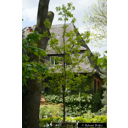Useful information about the taxon (species, subspecies, variety...)
Quercus rubra L. 1753
Fagaceae
(APG IV)Northern red oak, red oak
Taxon concept: The Plant List (2010)
Distribution: eastern Canada; eastern United States
Quercus rubra L. - Accepted: Quercus rubra L. bei Zander 2008; Familie: Fagaceae (Zander 2008)Quercus rubra L. - Accepted: Quercus rubra L. bei The Plant List (2010); Familie: Fagaceae (APG III)Quercus rubra L. - Accepted: Quercus rubra L. bei The Plant List (2014), version 1.1; Familie: Fagaceae (APG III)Quercus rubra L. - Accepted: Quercus rubra L. bei The Plant List (2014), version 1.1; Familie: Fagaceae (APG IV)Quercus rubra L. - Accepted: Quercus rubra L. bei Schmeil-Fitschen 2019; Familie: Fagaceae (APG IV)Quercus rubra L. - Accepted: Quercus rubra L. bei BfN Checklist Flora DE; Familie: Fagaceae (APG IV)Quercus rubra L. - Accepted: Quercus rubra L. bei World Flora Online - APG IV (Angiosperms); Familie: Fagaceae (World Flora Online - APG IV (Angiosperms))
- Flowers
- monoecious
- Flower ecology
- wind-pollinated (anemophilous)
- Life form
- woody, tree
- Foliage persistence
- deciduous
- Fruits
- acorns
- Fruit ecology
- gravity-dispersed (barochorous) and animal-dispersed (zoochorous) (by grey squirrels and blue jays)
- Root type
- strongly developed taproot
- Natural occurrence (habitat)
- pine-oak forests; dry slopes, sandy plains; edges of floodplains
- Vegetation typ and synecology (plant community)
- temperate, mixed mesophytic forests
- Endangerment of alien taxon in the region
- invasive
- Usage
- ornamental shade tree; wood is widely used for furniture, flooring and construction; very good firewood
- Phytopathogenic organisms
- susceptible to Oak Wilt caused by the fungus Ceratocytis fagacearum
- Bark
- grey to greyish-brown bark with shallow vertical furrows
Erhardt, W., Götz, E., Bödeker, N. & Seybold, S. (2008): Der große Zander. Enzyklopädie der Pflanzennamen. Band 2. Arten und Sorten. Eugen Ulmer KG, Stuttgart (Hohenheim), 18. Aufl., 2103 S.; Global Biodiversity Information Facilty (GBIF). Online Publication: www.gbif.org; Haider, M. et al. (2005): Wildbienenkataster. See: https://www.wildbienen-kataster.de; Kunkel, G. (1984): Plants for Human Consumption.. Koeltz Scientific Books, Königstein 3874292169.; Pritsch, Günter et al. (1985): Bienenweide.. Neumann-Neudamm, Melsungen; The International Plant Names Index (2009). Published on the Internet http://www.ipni.org; Courtesy to IPNI, 2009. Exported from IPNI at date: 2009-09-22 20:17:51; Tirmenstein, D. A. (1991): Quercus alba. In: Fire Effects Information System, [Online]. U.S. Department of Agriculture, Forest Service, Rocky Mountain Research Station, Fire Sciences Laboratory (Producer). See: https://www.fs.fed.us/database/feis/plants/tree/quealb/all.html; Westrich, P. et al. (2018): Die Wildbienen Deutschlands.. Ulmer Verlag ISBN 978-8186-0123-2.;
Diese Webseite verwendet Google Maps, um Karten und Standorte von Pflanzen in den Hohenheimer Gärten anzuzeigen. Dadurch werden unter Umständen Daten an Google weitergeleitet, was mit einer Verarbeitung Ihrer personenbezogenen Daten verbunden sein kann. Die Datenschutzerklärung von Google finden Sie hier: Datenschutzerklärung von Google
| Sex | Standort | Accession number | Planting year | Donation | IPEN | Lat. | Long. |
|---|---|---|---|---|---|---|---|
| Parzelle C | EG-C-028-20911 | 1986 | + | XX-0-HOH-EG-C-028-20911 | 48,7103006219 | 9,2051651853 | |
| Parzelle M | EG-M-086-20912 | 1820 | XX-0-HOH-EG-M-086-20912 | 48,7084570481 | 9,2088082695 | ||
| Parzelle E | SP-EB-016-2975 | XX-0-HOH-SP-EB-016-2975 | 48,7112369994 | 9,2117662415 | |||
| Parzelle E | SP-EB-023-9964 | 2019 | XX-0-HOH-SP-EB-023-9964 | 48,7111212414 | 9,2117943998 | ||
| Parzelle E | SP-EB-036-9969 | XX-0-HOH-SP-EB-036-9969 | 48,7109419307 | 9,2117947075 | |||
| Parzelle E | SP-EB-074-9992 | XX-0-HOH-SP-EB-074-9992 | 48,7106310691 | 9,2124007583 | |||
| Parzelle E | SP-EB-010-19101 | 2019 | + | XX-0-HOH-SP-EB-010-19101 | 48,7112866071 | 9,2116508689 | |
| Parzelle G | SP-GB-007-10004 | 2001 | XX-0-HOH-SP-GB-007-10004 | 48,7106768375 | 9,2128947378 |



